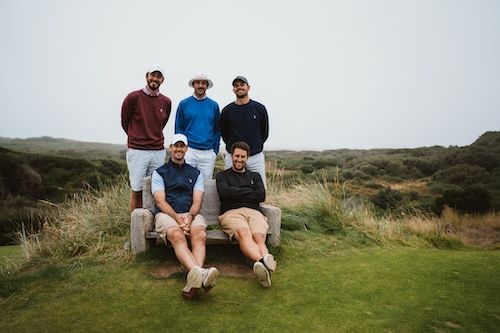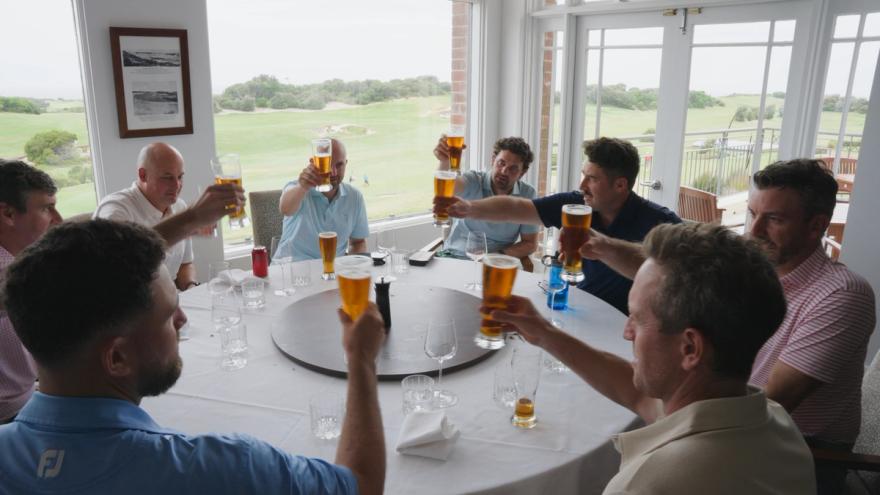Nick Dunlap was walking down the 18th fairway at PGA West on Sunday, holding a one-shot lead in a PGA Tour event, and trying to catch his breath. He was not ready to take his next swing.
“I was so nervous that I don't know if I could have done anything,” Dunlap said. “Most nervous I've ever been, by far. Just tried to breathe, but also look up and enjoy it a little bit. I've said it numerous times … it's a really cool spot to be in as an amateur. I don't ever want to forget today.”
By the time he reached his ball, he had calmed down. He did not look like a frightened 20-year-old, he looked — once again — like a hardened competitor.
The greater golfing world was just being introduced to Dunlap, but those of us who have been following his career for a while know that look well.
No, we weren’t bold enough to predict he’d become the first amateur to win a PGA Tour event since Phil Mickelson did it in 1991, but if you were paying attention, the signs were all there.
Dunlap couldn’t catch his breath last August in the U.S. Amateur either. Not accustomed to the high altitude, he spent the week at Cherry Hills in Colorado battling headaches and dehydration. But by the time the week was over, no one thought he was some lucky 19-year-old who’d caught lightning in a bottle.
He drew Gordon Sargent in his first match, and didn’t flinch against a player many regarded as the best amateur in the world. It was just two Alabama kids, a graduating class apart, trading birdies like they were Greek Gods throwing lightning bolts. When it was over, Dunlap had knocked out Sargent 2&1.
From there — his head clear and his body finally acclimated to the thin air of Colorado — Dunlap unleashed his own discomfort onto the rest of the draw. As the week went on, he was driving the ball 380 yards, holing unlikely putts and flexing some big-brain golf IQ that had you questioning where this kid came from. When the dust settled and the last putt dropped, he’d won the whole thing, the first player since Tiger Woods to win a U.S. Junior and a U.S. Amateur.
After that, he might have landed in your inventory of golfers to keep an eye on, especially after he helped lead the United States to retain the Walker Cup a few weeks later. But don’t pretend like you had Dunlap winning the American Express on your bingo card.
Outside of Mickelson and Woods, it’s always been hard to predict what amateur studs will become stars as pros. Unlike college football or college basketball, where we study players for years before they get drafted, the next generation of golfers is usually a mystery until they win.
Subscribe to No Laying Up Emails
If you enjoy NLU content, you'll enjoy NLU emails. We send our newsletter twice a month, and we send a Weekly Digest email. Get monthly deals, exclusive content, and regular updates on all things No Laying Up #GetInvolved

Unless you love spending most of your year refreshing HTML leaderboards and using your imagination to fill in the blanks of whatever photographic evidence you can assemble, amateur golf is a challenging sport to follow. Its spotlight shifts frequently throughout the year, the tournaments are rarely televised, and even in the fleeting moments we amateur golf junkies do get to enjoy some TV coverage, the product (in most cases) leaves a lot to be desired.
So I understand why Dunlap’s ascension may seem sudden. Or not what you expected.
But this is where I suggest you join me and engage in what might seem like strange behavior.
Come and appreciate the charm and excitement of amateur golf.
It can be so much more rewarding than listening to millionaires squabble over billions.
If you’re reading this, you’re probably a golf sicko already. So it’s not really a leap of faith. But there are so many great players like Dunlap on the cusp of breaking out or just itching to get their shot. They’re poised to clear out a lot of aging veterans at the next level.
Let’s go back to that Gordon Sargent guy for a second. He’s already earned his PGA Tour card (the first through PGA Tour U Accelerated) but he has deferred taking up membership until the end of his junior year – in hopes of finally earning Vanderbilt, consistently favored to win, a NCAA title. But he’s already done a few cool things, such as win an NCAA individual title, play in the Masters, finish as low amateur at the U.S. Open, and he’s already the winningest player in Vanderbilt history. Just to name a few.
He’s not the first guy to earn a PGA Tour card out of college. That was Ludvig Aberg – who you may have heard this company yapping about for several years. Yes, some players win eight times and college and disappear into the void of mini-tour professional golf. Aberg proved why that’s an antiquated practice: He broke out and won twice professionally, and was a contributor to the winning European Ryder Cup team.
Those last two names each became the No. 1-ranked amateur in the world. (Sargent still holds that honor.) But let’s dig a little deeper: Adrien Dumont de Chassart earned Korn Ferry Tour status by finishing third in PGA Tour U after his college career. Two months later, he earned his PGA Tour card. Michael Thorbjornsen, still an amateur, earned his second top-20 finish at the Dubai Desert Classic after not competing for five months. He’s first in line to earn a PGA Tour card when his college career ends in a few months. Oh, and remember that time he finished solo fourth at a PGA Tour event, the Travelers Championship?
Let’s continue our stroll down memory lane: What about the amateur who wound up in the final group on Saturday of the Masters in 2023? Yes, Sam Bennett. That one!
I could go on. Have you seen Christo Lamprecht’s swing? Ben James’ ball-striking?
In the words of Coach Prime, “Do you believe now?”
But there’s a more complex answer as to why this concentration of college stars is suddenly pulling a Kim Kardashian-peeking-through-the-bushes-GIF. Handing out Masters invites to winners of prestigious amateur events and giving out PGA Tour exemptions isn’t new. They’ve been hitting the ball farther, faster and smarter this whole time, too.
The only thing that’s changed is recognizing and rewarding the extent of these brilliant amateur careers. That thing called NIL helps a lot, too.
The best college players in the world used to picture life after turning pro as a fairly bleak and lonely endeavor. You might string together some exemptions, you might try to Monday qualify, driving all night from one tournament to the next, then struggle to parlay whatever money and success you could into a stable playing career. Think Brooks Koepka bouncing around Europe and Africa early in his career just trying to earn status. It would be like telling Victor Wembanyama he’s got to spend a few more years playing professional basketball in France if he REALLY wants to play in the NBA. Or asking Caleb Williams to play in a few UFL games and seeing how he stacks up there.
It feels silly to stop at awarding the best senior a PGA Tour card, or the most highly accomplished amateur within three years of his college career. Wouldn’t you love to see how the NCAA champion starts his PGA Tour career the week that follows? What about the U.S. Amateur champion? Even the best five players out of college?
Those opportunities, scant as they’ve been, were invaluable to Dunlap, particularly when he struggled with nerves or when he shanked a ball off the tee on No. 7 on Sunday.
Said Dunlap: “The PGA TOUR is giving an unbelievable opportunity to some of the top players, whether that's a junior or a senior or a fifth year or whatever that is, to go out and compete on the Korn Ferry Tour and showcase what they have, and I think that's been shown with Ludvig and some of the guys on the Korn Ferry Tour coming right out and having success. I've always said it, you know, to just see some of the players that are playing amateur golf in these college events and, you know, with the USGA, you play well, you know you're getting some spots in U.S. Opens and stuff like that. For me to be able to experience that at such a young age, it only helps me, and especially in some moments like today, to kind of bounce back on that and be like, hey, I've been in a situation like this. Obviously it's escalated now, it's on a PGA TOUR level, but to kind of look back on that, it was really helpful today.”
Allowing the newest crop of talent at the highest amateur level to start their PGA Tour careers right away is a lot more exciting than mule purgatory. No other sport protects its 45-year-old veterans the way golf does, letting them hold onto spots well past prime, and at a time when the PGA Tour could desperately use more intrigue, it no longer makes financial sense. Just look at the ratings that came out on Tuesday! Dunlap’s victory saw a 37 percent increase in eyeballs (535k) over Jon Rahm’s win at the American Express (391k) a year ago. With tournament sponsors backing out left and right and its future in question, this feels like a no-brainer.
What’s so hard about sacrificing a few more cards?
If you’re paying attention, you’re not sacrificing anything at all.
Email Jordan Perez at jordan@nolayingup.com.
Join The Nest
Established in 2019, The Nest is NLU's growing community of avid golfers. Membership is only $90 a year and includes 15% off at the Pro Shop, exclusive content like a monthly Nest Member podcast and other behind-the-scenes videos, early access to events, and more newsletter-exclusive written content from the team when you join The Nest.
